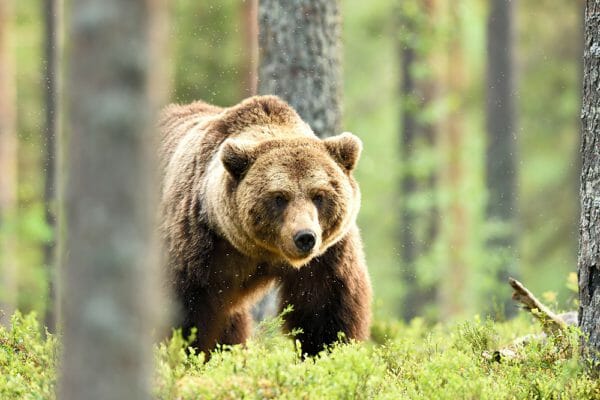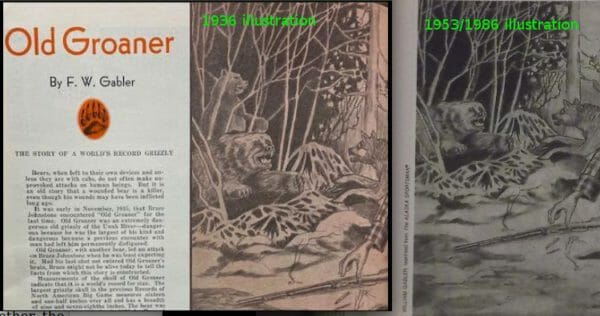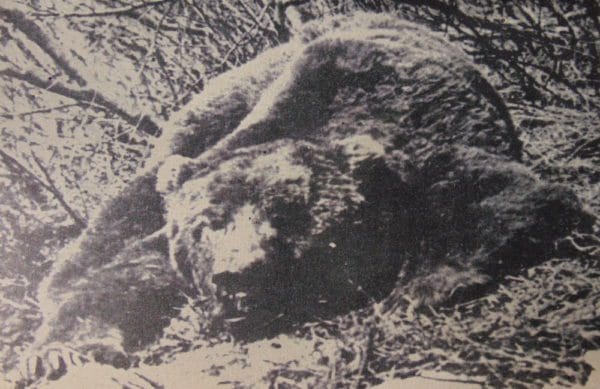
U.S.A. –-(AmmoLand.com)-– This is part III in a series of four segments on the Old Groaner legend. In segment I, the original article, published in the February 1936 issue of Alaska Sportsman is examined. In segment II, the 1953 re-write and some of the major changes in the rewrite are examined.
We may never know why the many changes were made to the Old Groaner story when it was re-written by W.H. “Handlogger” Jackson and published in the March issue of the 1953 Alaskan Sportsman as “The Moaning Marauder of Cripple Creek”.
In comparing accounts, the strong presumption is the closer to the original source, the more likely the accuracy of the account. The differences between the original article and the 1953 rewrite are several and significant. An obvious one is the changing of the 1936 illustration, apparently to fit the concept of the 1953 rewrite. In the 1936 article, there were two bears. In the 1953 rewrite, there was only one. The bear shown above and in back of Old Groaner has been taken out of the illustration.

From the 1936 article:
Old Groaner, with another bear, led an attack on Bruce Johnstone when he was least expecting it.
While attacks by more than one bear are usually a sow accompanied by one or more cubs, more than one bear being present during an attack by an adult boar has happened.
Bruce Johnstone, the man who shot Old Groaner in November of 1935, had three bears, a sow, a boar and a yearling cub, attack him at the mouth of the Unuk in a well-documented case about ten years later. Johnson thought surviving an attack by three bears was what he should be famous for.
The mouth of the Unuk is about 18 miles from Cripple Creek.
The area where Old Groaner was killed is a hot spot for bears. It was no surprise there might be more than one bear in the area.
In the 1936 article, Old groaner was not skinned because he was frozen, making it very difficult.
In the 1953 version, he was not skinned because the “hide was worthless” “no more hair than a hog”. The description was similar to that he gave a bear in an encounter Jackson had in 1946, as detailed in Jackson’s biography on page 181.
The further in time from the event, the more suspect memories become.
In the 1956 book, “Blood on the Arctic Snow”, the feature article is a re-write of the 1953 Alaska Sportsman “Moaning Marauder” article. There is a rare picture of Old Groaner before the head and paw were cut off, in the book.

The scarification of the right eye socket is visible; there seems to be plenty of fur. The dense vegetation matches the illustration by Gabler in 1936.
In “Blood on the Arctic Snow”, the three pictures of the skull are shown. The caption differs significantly from the 1936 caption. Here is the 1956 book’s caption for the picture of the skull:
Old Groaner’s skull, shown here in front, right, and rear views, is on display in the Alaskan Sportsman museum in Ketchikan. Arrow 1, shows where the right side of the skull had been shot away. The eye socket is almost closed and the jaw hinge is separated. Arrow 2 indicates the
shattered left eye arch, probably from a bullet fired in the same encounter. Arrow 3, point out the spot where Johnstone’s fatal bullet entered the bear’s brain cavity, and Arrow 5 shows were it lodged in the rear of the skull after passing through the brain. Arrow 4 indicates the worn and ulcerated teeth, evidence of Groaner’s advanced age. Arrow 6 indicates where a bullet from a side shot had entered just above the right eye. Five bullets were lodged in the head, and presumably had been there for twelve years.
The caption is the same as in the 1953 rewrite and in the 1956 book. The skull pictures are the same in the book, but the illustration by Gabler is not included. In the book, a picture of a bear footprint in the snow, an inside forest shot near the Unuk, and a landscape picture of the Unuk river country are included. In all three accounts, the error in the captions of the skull pictures persists: the claim is the left eye arch is shattered. In all pictures of the skull, the left eye arch is intact.
In the 1936 article, written two months after the event, when memories and the physical evidence were fresh, it was deduced three shots were fired in the initial wounding of Old Groaner, years before Old Groaner was killed. Two old bullets were found embedded in the head. Both were identified as .33 caliber jacketed rifle bullets.
The 1953 re-write (The Moaning Marauder of Cripple Creek), was written 17 years after the event where Old Groaner was killed, and 30 years after the disappearance of Jess Sethington. In the re-write, at least five shots were fired in the initial wounding, with five old bullets recovered from the bear’s head, three of which were .38 caliber pistol bullets.
LaVern Beier is a well-known bear expert who was a partner of Bruce Johnstone in his later years. He partnered with Johnstone when Johnstone was 65 and he was 17, and for several years afterward.
LaVern Beier wrote of the Old Groaner event, as he remembered hearing it from Bruce Johnstone before 1974, then writing it down on facebook on Jaunuary 13, 2022:
In June of 1935, while Bruce was prospecting on the Unuk River, he killed a famous brown bear of the era, that had stalked him, known as Old Groaner aka the Moaning Marauder of Cripple Creek. Old Groaner had 17 bullet holes in his skull from encountering a prospector years earlier.
The number of bullets fired in the first wounding of Old Groaner grew from three to five to at least 9 (17 holes), in merely 38 years!
The article was reprinted again in 1986. In the 1986 Alaskan Sportsman issues, the 1953 reprint covers most of ten pages split between January and February issues. There are pictures and illustrations, but none of the Old Groaner skull, head, or paw. The picture of Old Groaner in the 1956 book is absent.
In the 1986 re-publication of the 1953 re-write, there are many minor edits. They seem of little consequence to this correspondent, who would have used the original rather than make minor stylistic changes.
Two things stand out. In the 1953 re-write, a grizzly bear, far from the domain of Old Groaner, causes extensive damage to the Johnstone’s boat in 1933. In the 1953 rewrite, the grizzly is described as having done it in a “playful mood”. In the 1986 re-print, the words “playful mood” have been removed.
In the 1953 re-write, the pistol Jack Johnstone used to finish off the attacking bear on Sulphide Creek is identified as a Luger. In the 1986 re-publication, it is left unidentified.
In a 1994 interview of Bruce Johnstone, the dog Slasher, by grabbing Old Groaner’s hind foot, allowed Bruce Johnstone time to inflict the deadly shots on Old Groaner. In the 1994 interview, Johnstone says he used a .405 Winchester instead of a .38-72.
Without the revolver bullets, and the claim Jess Sethington owned a .38 revolver, the ties to Old Groaner and Jess Sethington become tenuous. It removes the presumption of where a person would have to be to place three revolver bullets under a bear’s jaw. The story becomes far less dramatic.
Could Jess Sethington have shot Old Groaner with his .33 Winchester, with the bear then coming to life unexpectedly, and killing him? It is possible. It is also possible some other person or Jess shot the bear and left the big grizzly for dead. Sethington could have disappeared any of many ways. As mentioned by both Gabler and Handlogger Jackson, there are many ways for a man to die on the Unuk river.
.33 Winchester rifles were not common, but they were not exceedingly rare. The writer of the 1953 re-write, W.H. “Handlogger” Jackson, owned a .33 Winchester, as noted in his biography. The bullets found embedded in the skull were examined by the two Johnstone brothers and George Lemmons. There is no record the bullets were measured.
The story was a good one. As stories told around a campfire will, it grew and grew. In Part IV, the modern mythology of Old Groaner will be examined.
About Dean Weingarten:
Dean Weingarten has been a peace officer, a military officer, was on the University of Wisconsin Pistol Team for four years, and was first certified to teach firearms safety in 1973. He taught the Arizona concealed carry course for fifteen years until the goal of Constitutional Carry was attained. He has degrees in meteorology and mining engineering, and retired from the Department of Defense after a 30 year career in Army Research, Development, Testing, and Evaluation.

from https://ift.tt/rsYmnEV
via IFTTT

No comments:
Post a Comment